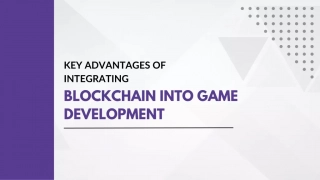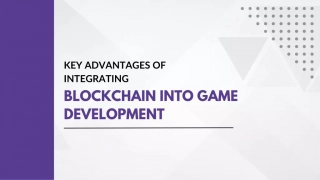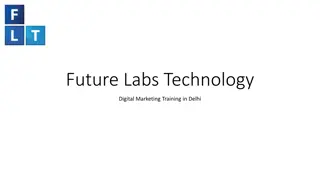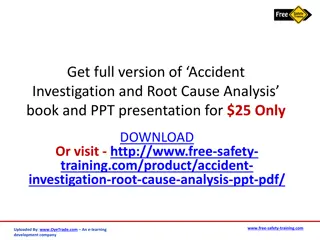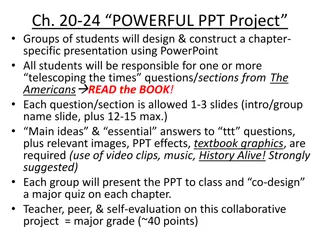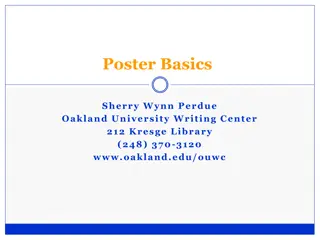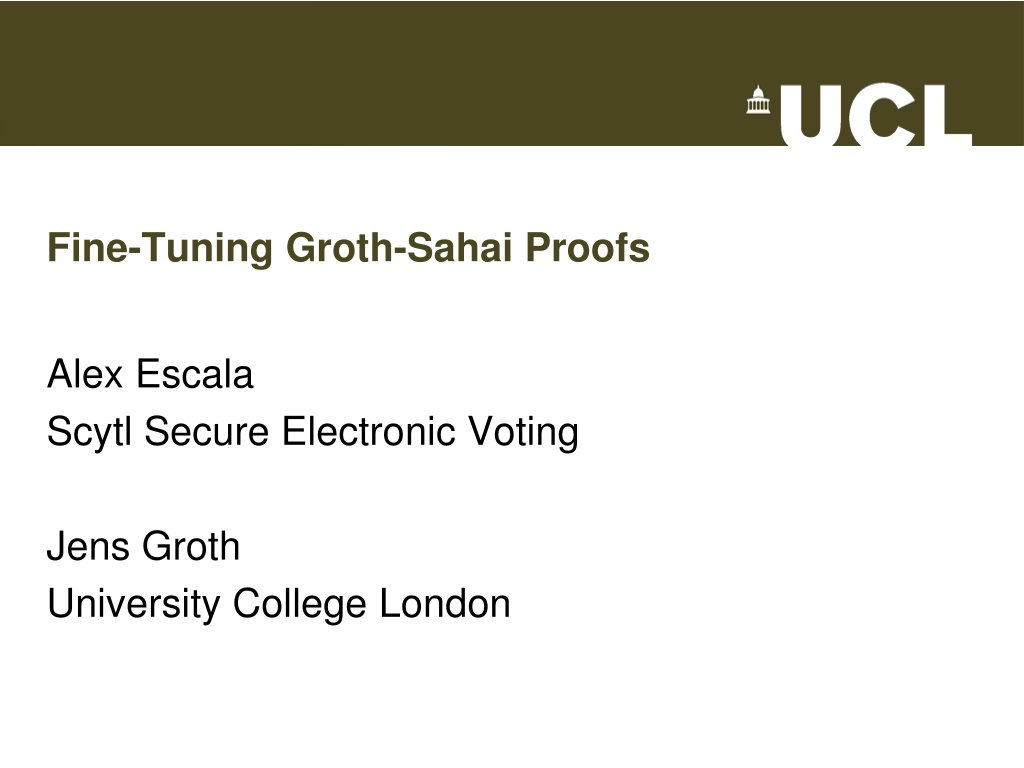
Introduction to Advanced Cryptography Techniques
Explore advanced cryptography techniques such as Groth-Sahai Proofs, Non-interactive Zero-Knowledge Proofs, Prime-Order Bilinear Groups, SXDH Bilinear Groups, and more. Learn about NIZK proofs, prime order groups, bilinear pairings, Group principals, and Groth-Sahai simultaneous satisfiability proofs in linear algebra notation.
Download Presentation

Please find below an Image/Link to download the presentation.
The content on the website is provided AS IS for your information and personal use only. It may not be sold, licensed, or shared on other websites without obtaining consent from the author. If you encounter any issues during the download, it is possible that the publisher has removed the file from their server.
You are allowed to download the files provided on this website for personal or commercial use, subject to the condition that they are used lawfully. All files are the property of their respective owners.
The content on the website is provided AS IS for your information and personal use only. It may not be sold, licensed, or shared on other websites without obtaining consent from the author.
E N D
Presentation Transcript
Fine-Tuning Groth-Sahai Proofs Alex Escala Scytl Secure Electronic Voting Jens Groth University College London
Non-interactive zero-knowledge proofs Common reference string Statement Completeness: Prover can prove true statements Soundness: Prover cannot prove false statements Zero-knowledge: Proofs does not reveal anything else 2
NIZK proofs Statement: Here is a ciphertext and a document. The ciphertext contains a digital signature on the document. Circuit SAT Pratical pairing- based statements 1 GB Inefficient Statistical sampling techniques Groth 2006 1 KB Efficient Groth-Ostrovsky- Sahai 2012 (2006) Groth-Sahai 2012 (2008) Further reduction of size More efficient computation 3
Prime order bilinear groups Gen(1?) generates (?, ?, ?,?,?, ?, ) ?, ?,? finite cyclic groups of prime order ? Pairing ?: ? ? ? ? ??, ??= ? ?, ? ?? ? = ? , ? = ,? = ? ?, Deciding group membership, group operations, and bilinear pairing efficiently computable 4
SXDH bilinear groups Three types of groups Type I: Symmetric, i.e., ? = ? Type II: Efficiently computable isomorphism ?: ? ? Type III: No efficiently computable isomorphisms in either direction between the source groups ? and ? SXDH assumption in Type III bilinear groups Decision Diffie-Hellman problem hard in both ? and ? 5
Groth and Sahai give NIZK proofs for simultaneous satisfiability a set of equations ??1,??2, over variables ?? ?, ?? ?,??,?? ??of the forms Pairing product equations ???= 1 ?( ??, ??) ?( ??, ??) ? ??, ?? ? ? ?,? Multi-exponentiation equations ?? ?????= ? ?? ?? ?? ?? ? ? ?,? Quadratic equations ????+ ????+ ???????= ? mod ? ? ? ?,? 6
Linear algebra notation Equations ??1,??2, over variables ?? ?, ?? ? Pairing product equations ???= 1 ?( ??, ??) ?( ??, ??) ? ??, ?? ? ? ?,? Use additive notation for groups, multiplicative notation for pairings to get Equations ??1,??2, over variables ?? ?, ?? ? Pairing product equations ? ? + ? ? + ? ? ? = 0 7
Groth-Sahai proofs Commitments ??? ?1,??? ?2, Proofs that committed values satisfy equations ???1,???2, 8
Commit-and-prove system [Kil90,CLOS02,Fuc11] ??? ?1 ??? ?1 ???1 ??? ?2 ???2 9
Type-based commit-and-prove system We commit to values ? = (?,?) with a public part (type) ? and a (potentially) private part ? Gen(1?) generates a commitment key ?? Com(??;?;?) generates commitment ? to ? = (?,?) Prove(??;?,?1,?1, ,??,??) generates proof ? for commitments ?1, ,?? containing witnesses ?1, ,?? certifying the veracity of the statement ? Verify(??;?, ?1,?1, , ??,??,?) verifies the proof and either accepts or rejects 10
Commitments to elements in ? Common reference string contains ? = ? , and ? = ? ? Commitment to ? ? ??? ?;?,? = ?(0,1) + ? ? + ? ? = ( ? + ?? ? , ? + ?? + ?) This is an ElGamal encryption of ? Zero-knowledge simulation uses CRS with ? = ? , and ? = ? ? ( 0, ) This makes the commitment perfectly hiding (?,? ??) (?,? ??) 11
ElGamal encryption of elements in ? Common reference string contains ? = ? , and ? = ? ? ElGamal encryption of ? ? ??? ?;?,0 = ?(0,1) + ? ? + 0 ? = (?? ,? + ?) Using ElGamal encryption can save computation and reduce proof sizes Zero-knowledge simulation uses CRS with ? = ? , and ? = ? ? ( 0, ) ElGamal encryption is not perfectly hiding, so be careful (?,? ??) (?,? ??) 12
Public constants in ? Common reference string contains ? = ? , and ? = ? ? Public ? ? can be trivially committed ??? ?;0,0 = ?(0,1) + 0 ? + 0 ? = (0, ?) This is easily verifiable as commitment to ? Simplifies pairing product equations to (?,? ??) (?,? ??) ? ? ? = 0 where some of the ?? s and ?? s may be public constants ??, ?? or ElGamal encrypted 13
Type-based commitments Generalize commitment scheme to allow many different types of commitments ??? ?, ? commit to public element ? ??? ? commit by ElGamal encrypting element ??? ? commit using Groth-Sahai commitment ???? ? commit to (public) element ? Similar types for elements in ? and also types for committing to elements in ?? Commitment format is ???(??; ?,? ;?) where we view ? as a public part and ? as a (potentially private) part of the committed message 14
The base type ???? ?, ;0,0 = (0,1) + 0 ? + 0 ? = (0, ) Why not just use (??? ?, )? Because in general we do not know discrete logarithm of ? in (??? ?, ?) but for we do, which helps in the zero-knowledge simulation In general Groth-Sahai proofs are not (directly) zero-knowledge if ? ? = 0involves pairings of public elements, but as it turns out they are zero- knowledge if the discrete logarithms are known ??? 15
Commitments All commitments to elements in ? are of the form 0 1 ? + ???+ ??? ??? ????, ? , ??,?? = where for some types ??= 0 or ??= 0 Let ? = ( ?1| | ??) be a matrix of the commitments, then we have 0 1 ? = ? + ???+ ??? Similarly, the matrix of commitments to elements in ? is ? = ? 0,1 + ?? ? + ?? ? 16
Proofs The equation to be proved is ? ? = 0 The proof is of the form ? ?, ? ?, ? ?, ? ? ? ? = ? ? ?,+ ? ? ?+ ? ? ? + ? ? ? Completeness 0 1 0 1 = 0 + something randomized ? ? = ? + ???+ ??? ? 0,1 + ?? ? + ?? ? ? ? 0,1 + something with ?, ?, ?, ? = 17
Soundness A standard CRS has vectors ?,? such that ? ? = 0 ? ? = 0 ?? = 0 ?? = 0 Define ? = ? ? and ? = ?? The verification equation gives us ? ? ?? = ? ? ? ?+ ? ? ?+ ? ? ? + ? ? ? ? = 0 so for each equation (? ?) ( ??) = ? ? = 0 ? 0,1 = 1 0 1? = 1 18
Zero-knowledge simulation for commitments In the simulation, the CRS contains ? = ? , and ? = ? ? ( 0, ) Since ?, ? are linearly independent, commitments using a simulated CRS are perfectly hiding The simulator knows types, but not values. Simulates commitments as follows Commits to 0 instead of making real commitments Can open base commitment ( 0, ) as 0,1 0+ ? ? ?, i.e., it can interpret it as a commitment to 0 Makes ElGamal type commitments as encryptions of 0 Makes (??? ?, ?) commitments as ( 0, ?) 19
Zero-knowledge simulation for proofs Given an equation ? ? = 0 the simulator needs to simulate proof ? ?, ? ?, ? ?, ? ?such that ? ? = ? ? ?,+ ? ? ?+ ? ? ? + ? ? ? Simulator can create proof if it knows openings ? = or more generally, if for each non-zero matrix entry ??? it knows openings to ??= 0 or ??= 0 (Restrictions on use of ElGamal encryptions though in order for the security proof to work) 0 1 0 + ???+ ??? or ? = 0 0,1 + ?? ? + ?? ? 20
Prover-chosen common reference string Common reference string I will use this CRS ??,??? Faster computation at the cost of sending a separate CRS and proving it is correct Good trade-off when many proofs to the same verifiers 21
Size: Reduced from 16 to 6 group elements ~63% Computation: Reduced ~40% Conclusion Commitment to ? may be reused many times, making a commit- and-prove scheme ideal Working in the SXDH setting we have fine-tuned Groth-Sahai proofs as follows Simplified notation Generalized to type-based commit-and-prove schemes Enabled the use of ElGamal encryption Allowed pairings of base elements ?, in equations Permitted the prover to choose her own CRS Weak Boneh-Boyen signatures ? + ? ? ? = ? Save a couple of group elements in each proof by using ElGamal encryption We can handle base elements directly Prover can reduce computation by using own key 22



